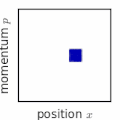from pylab import *
import subprocess
import sys
import os
figformat = '.png'
seterr(divide='ignore')
rcParams['font.size'] = 9
#define color map that is transparent for low values, and dark blue for high values.
# weighted to show low probabilities well
cdic = {'red': [(0,0,0),(1,0,0)],
'green': [(0,0,0),(1,0,0)],
'blue': [(0,0.7,0.7),(1,0.7,0.7)],
'alpha': [(0,0,0),
(0.1,0.4,0.4),
(0.2,0.6,0.6),
(0.4,0.8,0.8),
(0.6,0.9,0.9),
(1,1,1)]}
cm_prob = matplotlib.colors.LinearSegmentedColormap('prob',cdic,N=640)
### System dynamics ###
# potential is a polynomial
potential_coefs = array([1,0,0,4,-5,-4,0],'d')
def potential(x,t):
return polyval(potential_coefs,x)
# force function is its derivative.
force_coefs = (potential_coefs*arange(len(potential_coefs)-1,-1,-1))[:-1]
def force(x,t):
""" derivative of potential(x) """
return polyval(force_coefs,x)
invmass = 1.0
dt = 0.03
def motion(t,x,p):
""" returns dx/dt, dp/dt """
return p*invmass, -force(x,t)
cur_x = -0.1
cur_p = 0
def rkky_step(t, x_i, p_i, dt):
kx1,kp1 = motion(t, x_i, p_i)
dt2 = 0.5*dt
kx2,kp2 = motion(t+dt2, x_i+dt2*kx1, p_i+dt2*kp1)
kx3,kp3 = motion(t+dt2, x_i+dt2*kx2, p_i+dt2*kp2)
kx4,kp4 = motion(t+dt, x_i+dt*kx3, p_i+dt*kp3)
newx = x_i + (dt/6.0)*(kx1 + 2.0*kx2 + 2.0*kx3 + kx4)
newp = p_i + (dt/6.0)*(kp1 + 2.0*kp2 + 2.0*kp3 + kp4)
return newx, newp
### Setup ensemble points ###
# most are randomly chosen
x = 0 + 0.5*rand(20000)
p = -1.0 + 2.0*rand(20000)
# the pilot points are set manually
x[0] = 0; p[0] = 0
x[1] = 0.4; p[1] = 0.0
pilots = [0,1]
pilot_colors = {
0: (0,0.7,0),
1: (0.7,0,0)}
E = potential(x,0) + 0.5*invmass*p**2
### set up plot limits and histogram bins ###
xedges = linspace(-2.1,1.7,151)
pedges = linspace(-7.5,7.5,151)
Eedges = linspace(-9,9,151)
pix = 150
extent = [xedges[0], xedges[-1], pedges[-1], pedges[0]]
H = histogram2d(x,p,bins=[xedges,pedges])[0].transpose()
cmax = amax(H)*0.8
extenten = [xedges[0], xedges[-1], Eedges[-1], Eedges[0]]
Hen = histogram2d(x,E,bins=[xedges,Eedges])[0].transpose()
cmaxen = amax(Hen)*0.3
fig = figure(1)
ysize = 2.6
xsize = 1.3
fig.set_size_inches(xsize,ysize)
### Prepare lower plot ###
axen = axes((0.2/xsize,0.2/ysize,1.0/xsize,1.0/ysize),frameon=True)
axen.xaxis.set_ticks([])
axen.xaxis.labelpad = 2
axen.yaxis.set_ticks([])
axen.yaxis.labelpad = 2
xlim(-2.1,1.7)
ylim(-9,9)
xlabel('position $x$')
ylabel('energy')
potx = linspace(-2.1,1.7,151)
### Prepare upper plot ###
ax = axes((0.2/xsize,1.5/ysize,1.0/xsize,1.0/ysize),frameon=True)
ax.xaxis.set_ticks([])
ax.xaxis.labelpad = 2
ax.yaxis.set_ticks([])
ax.yaxis.labelpad = 2
xlim(-2.1,1.7)
ylim(-7.5,7.5)
xlabel('position $x$')
ylabel('momentum $p$')
### Start running simulation ###
frames = list()
delays = list()
framemod = 5
frame = "frames/background"+figformat
savefig(frame,dpi=pix)
frames.append(frame)
delays.append(16)
print "generating frames... 0%",
sys.stdout.flush()
savesteps = range(0,401,framemod) + [600, 1000, 2000, 6000]
delays += [10]*len(savesteps)
delays[1] = 200
delays[-5:] = [100,200,200,200,400]
totalsteps = max(savesteps)+1
for step in range(totalsteps):
if step % 20 == 0:
print "\b\b\b\b\b{0:3}%".format(int(round(step*100.0/totalsteps))),
sys.stdout.flush()
if step in savesteps:
# Every several frames, do a plot
remlist = list()
sca(ax)
H = histogram2d(x,p,bins=[xedges,pedges])[0].transpose()
remlist.append(imshow(H, extent=extent, cmap=cm_prob, interpolation='none', aspect='auto'))
remlist[-1].set_clim(0,cmax)
for i in pilots:
remlist += plot(x[i], p[i], '.', color=pilot_colors[i], markersize=3)
E = potential(x,step*dt) + 0.5*invmass*p**2
sca(axen)
pot = potential(potx,step*dt)
remlist += plot(potx,pot,color='r',zorder=0)
Hen = histogram2d(x,E,bins=[xedges,Eedges])[0].transpose()
remlist.append(imshow(Hen, extent=extenten, cmap=cm_prob, interpolation='none', aspect='auto',zorder=1))
remlist[-1].set_clim(0,cmaxen)
for i in pilots:
remlist += plot(x[i], E[i], '.', color=pilot_colors[i], markersize=3)
frame = "frames/frame"+str(step)+figformat
savefig(frame,dpi=pix)
frames.append(frame)
# Clear out updated stuff.
for r in remlist: r.remove()
x, p = rkky_step(step*dt, x, p,dt)
print "\b\b\b\b\b done"
assert(len(delays) == len(frames))
### Assemble animation using ImageMagick ###
calllist = 'convert -dispose Background'.split()
for delay,frame in zip(delays,frames):
calllist += ['-delay',str(delay)]
calllist += [frame]
calllist += '-loop 0 -layers Optimize _animation.gif'.split()
f = open('anim_command.txt','w')
f.write(' '.join(calllist)+'\n')
f.close()
print "composing into animated gif...",
sys.stdout.flush()
subprocess.call(calllist)
print " done"
os.rename('_animation.gif','animation.gif')




